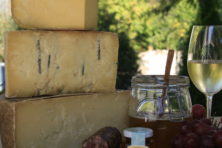The Cheese Insider
- Share
- Tweet
- Pin
- Share
There are four types of milk used to make cheese: cow, goat, sheep, and buffalo. The most common milk used is from cows, and the least common is buffalo, which is mainly used to make mozzarella cheese. Over the past decade in the United States we have seen a huge increase in the number of cheeses being made with goat and sheep milk, and the use of mixing different milk types for one type of cheese. Most cheeses that are of the “mixed milk” variety are made up of two milks, although one of the very good artisan cheeses made here in Wisconsin, Casa Bolo, by Carr Valley Cheese, is made with a combination of all three milk types, goat, sheep, and cow.
Milk contains four major constituents: fat, protein, lactose (carbohydrates or sugar), and minerals (water). Water is by far the most abundant constituent in milk. Listed below is a general breakdown of the fat, protein, and lactose of each milk type, not including buffalo.
Cow Goat Sheep
Fat 4.2 3.6 7.0
Protein 3.4 3.2 5.6
Lactose 4.8 4.5 4.8
Total Solids 12.7 12.4 19.3
Sheep’s milk also has greater amounts of riboflavin, thiamine, niacin, pantothenic acid, vitamin B, calcium, sodium, magnesium, zinc, and iron. Generally goat’s milk has greater amounts of these vitamins and minerals than cow’s milk, with the exception of riboflavin, folic acid, and vitamin B 12.
Goat and sheep’s milk are good alternatives for people who may have difficulty drinking cow’s milk. Allergies to protein in cow’s milk are common, and it is a bit more difficult for the human body to digest. Goat and sheep milk is naturally homogenized; the fat particles are smaller and evenly distributed throughout the milk, rather than the separation of cream in cow’s milk. Although goat and sheep milk is richer in nutrients both animals produce far less quantity than cow’s milk (and the cheese they produce). One exception to this is the Jersey cow, which contains more protein, minerals, vitamins, and butterfat than any other breed of cow.
As you see from the chart above, the composition of each milk type presents different opportunities for cheesemakers. In Europe they have been making great cheese from both goat and sheep milk for centuries. The fresh chevre made with goat milk is a staple in France, while the Spanish and Italians are known for many of the world’s best sheep milk cheese.
In Wisconsin we now have a group of artisan cheesemakers producing some great goat and sheep milk cheeses. Katie Hedrich of LeClaire Farms in Chilton, WI, has been making a variety of cheeses using the milk from her family’s herd of goats. Her Evalon, a raw milk, Gouda style goat cheese won the U.S. Cheese Championship last year. Hedrich is the second youngest person, and only the second female to have won this prestigious award. Brenda Jensen of Hidden Springs dairy in Westby, WI, is known for her fantastic sheep milk cheeses, including, Oouch Mountain, Timber Coulee, both semi hard cheeses as well as her Driftless cheese which is a fresh, soft cheese similar to chevre. Both of these women are continuing to look for new cheeses to make with the goat and sheep milk from their farms.
Two of my favorite cheeses are Dante, a Spanish Manchego style sheep cheese, from the Wisconsin Sheep Co-op, and Bohemian Blue a sheep milk blue cheese made by Tony Hook in Mineral Point, using the sheep milk from Brenda Jensen. Both of these cheeses are full of deep, rich flavor, with a very smooth finish, a characteristic of sheep milk cheese.
I also enjoyed a cheese made by Master Cheesemaker Sid Cook at Carr Valley Cheese called Snow White Goat Cheddar. This cheese has a beautiful white color and loaded with flavor that comes from cave-aging the cheese for a year. Sid also makes a beautiful sheep milk cheese called Marisa, named for his only daughter. This cheese is cave-aged for a year and has a wonderful bounty of flavors.
Sources: Artisan Farmstead Cheese by Paul Kindstedt and Murray’s Cheese Handbook by Rob Kaufelt
Michael C. Thomas is co-owner of Schoolhouse Artisan Cheese with his wife Janice. With locations in Ellison Bay and Egg Harbor, they aim to bring the best of Wisconsin artisan cheeses to Door County, and with “The Cheese Insider” Michael hopes to bring all things cheese to readers of the Pulse.



